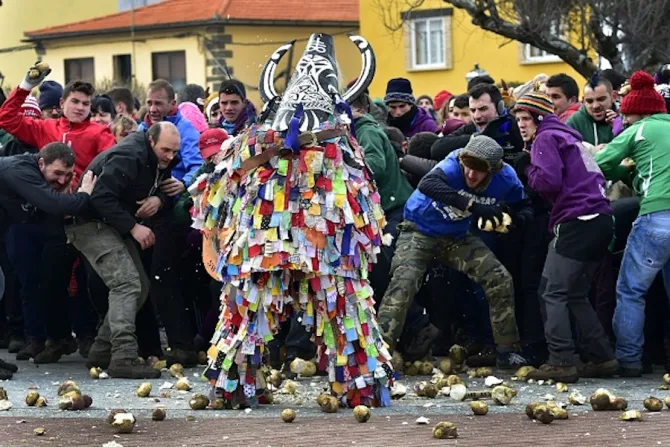Piornal, Spain, Jan 12, 2020 / 05:00 am
Every year on the feast of St. Sebastian, a young man from the Spanish village of Piornal dons a suit covered in colorful strips of cloth, He puts on a large, coned-shaped monster mask, and a head covering with long horns - along with plenty of protective gear underneath.
Once dressed, the monster, called Jarramplas, parades through village streets to be pummeled with tons of turnips- quite literally- chucked with gusto by his fellow villagers.
At the end of the two-day beating, which concludes annually on the feast of St. Sebastian, the Jarramplas and the whole village attend Mass and then a celebratory meal.
As soon as Jarramplas removes his mask, the young man underneath is celebrated as a hero by his turnip-wielding antagonizers.
Javier Prieto, mayor of Piornal, told Spanish newspaper 20 Minutos that the excitement surrounding the Jarramplas festival surpasses even that of Christmas.
"Christmas here (flies by) and people think more about Jarramplas than Christmas itself," he said. Starting around December 20, a month before the festival, "There is no talk of anything else."
Prieto boasts that the village plans to purchase roughly 31 tons of turnips from a local farmer for the event this year.
The festival is, like many customs, too ancient for most locals to know much about how it got started.
There are many theories as to who, exactly, the Jarramplas represents. One theory is that he represents St. Sebastian, because the barrage of beet-like vegetables harkens to the slew of arrows that pierced the saint.
According to tradition, St. Sebastian was an early Christian sentenced to death by the Roman emperor Dioclesian for helping and caring for imprisoned Christians. St. Sebastian miraculously survived the arrows, but later was beaten to death by Roman soldiers and is a martyr of the Church. His feast day is celebrated on January 20.
Carlos Colón, a Spanish historian, told CNA that in his view, Jarramplas is not about St. Sebastian, even though the celebration coincides with the feast of St. Sebastian and has become connected to its liturgical celebration.
Instead, the monster represents a legendary, infamous bandit who pilfered livestock and vegetables from the villagers long ago until they got their revenge, Colón said.
"It's a legend about a crook, a bandit that stole cattle and vegetables from the locals and the legend says that the people from the town one day gathered and stoned him," the historian explained.
Each year, the village has commemorated the event, "they threw potatoes and now it's turnips." Sebastián Díaz Iglesias, an anthropologist from Piornal who wrote his doctoral thesis on Jarramplas, told Atlas Obscura in 2019 that the exact origins of Jarramplas are quite murky, as much of the town's historical record was destroyed during the Spanish Civil War. The earliest account of the festival he can find dates it only to 1898.
The tradition of Jarramplas may have come from pre-Christian Celts in the area, as a ceremonial cleansing of the town, Diaz said. Or it could be a derivative of a Roman fertility festival that took place in February, or a Native American tradition brought back to Spain.
Jarramplas also might have started as a symbolic driving out of Christians who converted to Islam during the Muslim conquest, or a ceremony symbolizing the driving out of the Black Plague, Diaz theorized.
Likely, he added, it has multiple origins and is a melding of Christian and pagan traditions. The name may have come from the word "arramplar," which means "to make off with everything," Diaz told Atlas Obscura.
(Story continues below)
While the festival almost died off in the 1970s, its popularity has enjoyed a resurgence in more recent decades. The waitlist for young boys to become the Jarramplas is years long, Prieto said, and is currently booked up through 2043. Every year about five more boys are added to the list, usually signed up by their parents.
Prieto told 20 Minutos that the 1,600 person town expects "a massive influx" of people for the festival, wanting to join in the turnip-chucking fun, and that he was working on health and safety measures in the cases where turnips miss their target and hit someone else.
Spain correspondent Blanca Ruiz contributed to this report.



